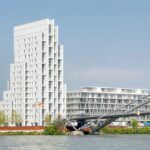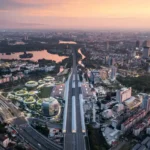Besançon Train Station Building, TGV France, French Railway Architecture
Besançon Train Station : Railway Building in France
French Train Station building design by AREP
23 Jul 2012
Gare de Besançon Franche-Comté TGV
Design: AREP Architects
Besançon Train Station Building
Location: Franche-Comté région, north-east France
Nouvelles gares TGV Rhin-Rhône, 19 décembre 2011 – Gare de TGV Besançon Franche-Comté TGV
Architects: JM Duthilleul, F. Bonnefille, J-F Blassel, Agence Territoires (Paysagiste)
Besançon Franche-Comté TGV railway Station
Built on the Rhin-Rhône high-speed rail line, Besançon Franche-Comté TGV station is located on a site straddling the communes of Auxon-Dessus and Auxon-Dessous in the Doubs département, Franche-Comté region.
Echoing the citadel of Besançon, the new station’s stone walls spread out across a wooded, undulating landscape traversed by the high-speed rail line. Both Land Art and a functional design linking one means of transport to another, it welcomes travellers with an elegant composition of walls and walkways inserted into the landscape. Under a wide roof forming a natural extension of the terrain to the south, the station building stretches from the parking areas all the way to the platforms, via the passenger hall.
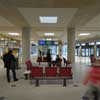
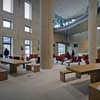
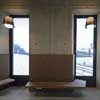
photos : SNCF-AREP / photo C.Delettre
The hall contains all the passenger facilities and provides direct access to the platforms, reached via walkways and gently sloping ramps. Built on the same level as the forecourt, it offers disabled travellers direct access to the station’s services and shops. The forecourt has set-down areas for cars and taxis, a bus station and cycle shelters. A heavy-step ramp links the passenger hall to the parking areas above, laid out either side of a tree-lined walkway crossing them to the south.
At platform level there is a pre-boarding room offering passengers views of the landscape to the west, plus the station’s operations rooms.
The station expresses synthesis between nature and technology. It is also one of the first stations in France to obtain High Environmental Quality (HEQ) certification.
Contracting owner: SNCF Gares & Connexions
Project management: SNCF Gares & Connexions and AREP (Jean-Marie Duthilleul, Étienne Tricaud, François Bonneflle, Fabienne Couvert)
Delivery: December 2011
ENVIRONMENTAL APPROACH
The design process was informed from the outset by an environmental approach and profile, with the building conceived both to respect the site and to minimize its environmental impact. Its volume moulds organically with the landscape, drawing its thermal performance and low energy consumption from its ground-hugging design.
THE PROJECT AND ITS IMMEDIATE ENVIRONMENT
Morphology of the building and its layout on the site The building runs along a natural slope, offering a low, discreet façade development.
The grass-covered roof of the extension to the slope allows uninterrupted visual continuity with the surrounding wooded terrain, as the volume of the upper entrance – a strong “signal” of the station in the landscape – is the only component that stands out. The car park areas create a highly landscaped overall view.
Snaking across the hillside and separated by copses, they were designed with the aim of preserving the wooded character of the site as much as possible. The choice of vegetation corresponds to the local plant life, so as not to disturb existing ecosystems.
Moulding to the naturally sloping terrain, the car parks rise in terraces edged with planted channels for clean, ecological management of runoff water.
The planted areas represent 42% of the overall plot and around 50% of the building’s envelope.
Although the station site is far from urban centres, it is designed as a focal hub for a large region. It is well served by conventional public transport (buses and local trains) and also of-fers facilities for green and clean connections (bikeways, electric cars).
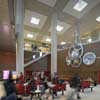
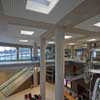
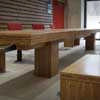
photos : SNCF-AREP / photo C.Delettre
ENERGY CONTROL AND HYGROTHERMAL COMFORT
The station design applies a bioclimatic approach, through its morphology and layout on the site, in order to minimize energy needs passively both in summer and in winter.
The wide temperature range of the local continental climate was taken into account in the station’s design. Laid out in a north-south direction, perpendicular to the high-speed rail lines, the building turns its back on the dominant west/south-west winds and is protected from solar radiation from the south.
Moulding itself to a natural slope in the landscape, the building benefits from the thermal inertia of the ground, plus the inertia provided by the concrete structure and the roof. The ground-hugging layout allows optimum façade development, with a moderate number of east and north-facing windows to minimize energy loss. The design is completed by air locks at the entrances, exterior thermal insulation, and energy-efficient glazing.
A series of skylights in the roof provides comfortable overhead natural lighting.
Renewable energy systems for thermal comfort of travellers A system of geothermal air exchangers supplies the station with cool or preheated air at no cost: outside air is sucked into underground conduits, where it is cooled in summer and heated in winter. The energy gain is around 10% of the total energy needed for thermal comfort.
A 150 kW wood-fired boiler covers 90% of heating needs. This model represents an annual reduction of 100 tonnes of CO² compared with a standard gas boiler.
A sun-friendly roof
Transparent photovoltaic roof panels covering a total area of 292 m2 provide 23.60 kWhPE/m²/year of electricity (kWh of primary energy per square metre of usable floor space per year). This electricity production represents 13% of the station’s total conventional primary energy consumption of 174 kWhPE/m²/year, for a usable floor area of 2,555 m². Also on the roof are eight solar thermal sensors, covering an area of 20 m², which provide 30% of energy requirements for production of hot water.
RAINWATER COLLECTION AND CONTROL OF WATER QUALITY
The rainwater collection principle applied at Besançon Franche-Comté station meets environmental requirements.
The system recovers all rainwater from the road and parking surfaces, pedestrian walkways and station roofs. The aim is to filter this water on site and minimize discharge of pollutants into the CAPE, the high-speed line’s drainage network.
The principle relies on a system of planted channels providing phytoremediation of runoff water. Running along the edges of the parking terraces, the channels are sown with grasses specially chosen for their filtering qualities. Water from the road surfaces is collected in them and cleaned a first time.
Owing to the clayey nature of the soil, a system involving seepage of water into the ground could not be envisaged. A large channel was therefore dug at the bottom of the slope to collect all rainwater (from terrace channels, forecourt and roofs) plus waste water filtered on site. After passing through an oil separator, the water is sent via the CAPE to a storage basin located downstream of the station site, near the high-speed line.
Almost all of the building’s roof surfaces are covered with grass, which retains some of the runoff water and slows down discharge into the drainage network. Runoff water recovered from the roofs is stored for cleaning rental vehicles.
Waste water is treated on site, in a micro purification facility equipped with sand filters and filtering plants. Water treated in this way is as clean as rainwater.
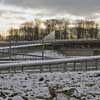
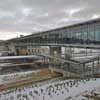

photos : SNCF-AREP / photo C.Delettre
MAINTENANCE AND LONG-TERM ENVIRONMENTAL PERFORMANCE
The technical areas are easily accessible and well proportioned for comfortable handling and maintenance.
The technical networks (heating/cooling, ventilation, lighting, water) can be easily inspected via an underfloor crawl space extending under the entire building.
The lighting maintenance systems are also easily accessible.
The hot and cold networks are sectorized.
The ventilation networks follow a simple design, with two air handling units corresponding to the public zones and the operations zones.
Conditions in each zone are monitored by the electronic/digital building management system (BMS). Each zone has its own operating conditions. The BMS also monitors consumption.
The water management system is standard.
The electromechanical systems (automatic doors, escalators, lifts) have secondary access for easy maintenance.
Inauguration des nouvelles gares TGV Rhin-Rhône, 1er décembre 2011 – Gare de Besançon Franche-Comté TGV Arch.: JM Duthilleul, F. Bonnefille, J-F Blassel, Agence Territoires (Paysagiste SNCF-AREP):
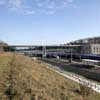
photo : C. Delettre
OLFACTORY COMFORT AND AIR QUALITY
The operations and public areas are ventilated by a two-way mechanical flow system with energy recovery. The supply of clean air is regulated according to human presence or the level of activity in the different areas.
At night in summer the public areas can be ventilated naturally by thermal draft. Outside fresh air provides the building with free cooling.
The air processing networks have a high watertightness class.
The geothermal air exchangers are made of impervious pipes in food grade high-density polyethylene (HDPE), preventing any contamination of the fresh air (by radon present in the ground, for example). Outside fresh air, in no contact with any pollution source, is filtered before being blown inside the building.
LOW ENVIRONMENTAL IMPACT
The project was carried through in accordance with the “green site charter” which defines organizational and operational principles, in particular:
– management and recovery of building site waste
– limitation of acoustic and visual disturbance and pollution caused by dust, mud and concrete
– limitation of water, soil and air pollution
– limitation of consumption of resources (water, top soil, energy).
The site management and coordination unit, assisted by an environmental design office, was tasked with supervising building work in accordance with the green site charter.
Gare de Besançon Franche-Comté TGV (nov. 2011) en cours d’achèvement (nov. 2011).Vue de la gare depuis les parkings Architectes : JM Duthilleul, F. Bonnefille, E. Tricaud SNCF-AREP:
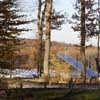
photo : C. Delettre
Besançon Train Station images / information from AREP
Location: Besançon, France
New Buildings in France
French Architectural Projects
French Architect Offices – design firm listings
Paris Architecture Tours by e-architect
Railway Train Station Buildings in Europe – Selection
Liege-Guillemins Railway Station, Belgium
Santiago Calatrava Architect

photo : www.palladium.de, B.Burg / O. Schuh
TGV Railway Station Belgium
Bruxelles Gare du Midi, Brussels, Belgium
Ateliers Jean Nouvel
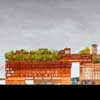
image © Ateliers Jean Nouvel
Brussels Railway Station Building
French Architecture – Selection
Médiathèque Romain Rolland, Paris
Philippe Gazeau architecte
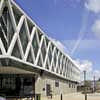
picture : Philippe Ruault
Médiathèque Romain Rolland
Dijon Mustard Lab, eastern France
MVRDV Architects

photo : MVRDV
Dijon Building
Scenographic Huts, Briançon, Provence-Alpes-Côte d’Azur, southeast France
Hérault Arnod Architectes
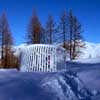
image : Hérault Arnod Architectes
Briançon Buildings
Comments / photos for the Gare de Besançon Franche-Comté TGV – French Train Station Building page welcome
Website: Gare de Besançon Franche-Comté TGV

